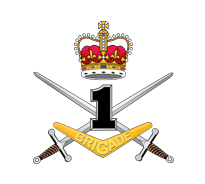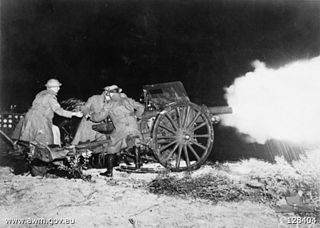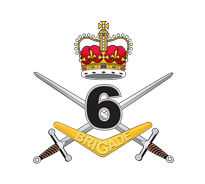
The Australian Army Reserve is a collective name given to the reserve units of the Australian Army. Since the Federation of Australia in 1901, the reserve military force has been known by many names, including the Citizens Forces, the Citizen Military Forces, the Militia and, unofficially, the Australian Military Forces. In 1980, however, the current name—Australian Army Reserve—was officially adopted, and it now consists of a number of components based around the level of commitment and training obligation that its members are required to meet.

The 25th/49th Battalion, Royal Queensland Regiment is a Reserve light infantry battalion in the Australian Army, based in the state of Queensland. Although it was officially formed in 1997, the unit can trace its lineage back to units that were formed in 1875 as part of the colonial defence force of the state of Queensland. Additionally, in order to preserve the honours and traditions of the Australian Imperial Force, the battalion is the custodian of the battle honours awarded to two battalions that were formed for service during World War I. Following the end of the war, these units were raised again as militia units. During World War II, these battalions were called upon to participate in the fighting in the Pacific. Following the end of the war, these units were disbanded although they were later re-raised as part of the Citizen Military Forces, which was the forerunner to the Australian Army Reserve that exists today.
The 25th Battalion was an infantry unit of the Australian Army. Raised in early 1915 as part of the Australian Imperial Force during the First World War, the battalion fought at Gallipoli and in the trenches along the Western Front, before being disbanded in early 1919. In mid-1921, it was re-formed as a part-time unit based in the state of Queensland. Throughout the 1930s, the battalion was merged briefly with the 49th Battalion as a result of manpower shortages, but was later re-raised in its own right. During the Second World War, the 25th deployed to New Guinea where they fought the Battle of Milne Bay in August and September 1942. Later in the war, the 25th took part in the Bougainville Campaign. During the post-war period, the 25th Battalion became part of the Royal Queensland Regiment, variously forming battalion or company-sized elements, before being merged with the 49th Battalion to form the 25th/49th Battalion, Royal Queensland Regiment.

7th Brigade is a combined arms formation or brigade of the Australian Army. The brigade was first raised in 1912 as a Militia formation, although it was re-formed as part of the First Australian Imperial Force in early 1915 for service during World War I. It subsequently saw action at Gallipoli and on the Western Front during the war. Following the end of the war the brigade was disbanded in 1919 before being re-raised in 1921 as part of the Citizens Force. During World War II the brigade took part in the fighting against the Japanese in New Guinea and on Bougainville. Today, the 7th Brigade is part of Forces Command and is based in Brisbane, Queensland and is composed mainly of units of the Regular Army. While the brigade has not deployed as a whole unit since World War II, component units have deployed on operations to East Timor, the Solomon Islands, Iraq and Afghanistan.

1st Brigade is a combined arms formation of the Australian Army. Formed in 1903 as a militia formation based in New South Wales, it was reconstituted as part of the Australian Imperial Force in 1914 for service during World War I, the brigade fought at Gallipoli and on the Western Front before being disbanded in mid-1919. In 1921, the 1st Brigade was re-raised as a unit of Australia's part-time military forces, based in New South Wales. During World War II the brigade undertook defensive duties before being disbanded. In 1948, it was re-raised as an integral part of the Australian Regular Army. Currently the brigade is based at Robertson Barracks in Darwin and at RAAF Base Edinburgh near Adelaide, South Australia. It is the first of the Australian Army brigades to be re-organised as a combat brigade under Plan Beersheba.

The 3rd Battalion, The Royal Australian Regiment is a mechanised infantry battalion of the Australian Army, based in Kapyong Lines, Townsville as part of the 3rd Brigade. 3 RAR traces its lineage to 1945 and has seen operational service in Japan, Korea, Malaya, Borneo, South Vietnam, Rifle Company Butterworth, East Timor, the Solomon Islands, Afghanistan and Iraq.

Enoggera Barracks is an Australian Army base in the northwestern Brisbane suburb of Enoggera in Queensland. It was officially established in the early 20th century when the area was used for field training, although the area was used by military units as far back as the mid-19th century. Since then it has been developed into a modern military base, which is now home to units of the 7th and 11th Brigades as well as the headquarters of the 1st Division and the 16th Aviation Brigade.

The 8th/9th Battalion, Royal Australian Regiment is a motorised infantry battalion of the Australian Army. It was originally formed in 1973 by linking together both the 8th and 9th Battalions of the Royal Australian Regiment. Over the next twenty-four years the battalion would remain on the Australian Order of Battle based at Enoggera Barracks in Brisbane, Queensland, until it was disbanded in 1997 amid a number of Defence-wide cutbacks introduced by the Howard government. In 2006 it was announced that the battalion would be re-raised as part of a plan to expand the size of the Army and since then it established itself as a fully deployable motorised infantry battalion as part of 7th Brigade.

The 1st Regiment, Royal Australian Artillery is a close support regiment attached to the 7th Brigade at Enoggera Barracks in Queensland. The unit was formed in 1914 under the name 1st Australian Field Artillery Brigade, part of 1st Division Artillery during World War I and later served in World War II and the Vietnam War. It is currently re-equipping with M777A2 lightweight towed howitzers.

Overwatch Battle Group (West) was an Australian Army battlegroup that represented Australia's largest contribution to the Multinational force in Iraq. The Battle Group was established in July 2006 and was based at Tallil Airbase in Dhi Qar Governorate, consisting of units previously assigned to the third, and final, rotation of the Al Muthanna Task Group. It was withdrawn in June 2008.

The Royal Australian Army Ordnance Corps (RAAOC) is the Corps within the Australian Army concerned with supply and administration, as well as the demolition and disposal of explosives and salvage of battle-damaged equipment. The Corps contains clerks, operator supplies, petroleum operators, parachute riggers and ammunition technicians. Members of the Corps are nicknamed Roaches.

The 5th Battalion, Royal Australian Regiment is a regular motorised infantry battalion of the Australian Army. Originally established in 1965 it would serve two tours of South Vietnam before it was linked with the 7th Battalion to form the 5th/7th Battalion, Royal Australian Regiment in 1973. In late 2006 the two units were de-linked, and 5 RAR again joined the Australian Army's order of battle in its own right. It has since served in Iraq, East Timor and Afghanistan.

The Royal Australian Corps of Transport (RACT) is a corps within the Australian Army. The RACT is ranked tenth in seniority of the corps of the Australian Army, and is the most senior logistics corps. It was formed on 1 June 1973 as an amalgamation of the Royal Australian Army Service Corps (RAASC) and Royal Australian Engineers Transportation Service. The RACT is responsible for the operation of army surface transport assets, movement control, terminal and postal services, and Army aspects of air logistic support.
8th Combat Service Support Battalion is a unit of the 5th Brigade of the Australian Army. Originally formed as 8th Brigade Administrative Support Battalion in 1995, 8 CSSB is a part-time Army (Reserve) unit with elements at the Timor Barracks at Dundas (Sydney) and the Bullecourt Barracks at Adamstown (Newcastle). At various times in the past, the unit has had elements at Erina, Taree and Pymble.
The 2nd Combat Engineer Regiment(2 CER) is an Australian Army combat engineer regiment located at Gallipoli Barracks in Brisbane, Queensland. It is part of the Australian 7th Brigade, attached to Forces Command (Australia).
The 1st Combat Engineer Regiment is a combat engineer regiment of the Australian Army. Based in the Northern Territory and attached to 1st Brigade, it is a Regular Army unit of the Royal Australian Engineers and is tasked with providing mobility and counter mobility support.

The 6th Combat Support Brigade is an Australian Army brigade. First formed in 1912 as a Militia formation to provide training under the compulsory training scheme, the brigade was re-raised during the First World War as an infantry unit of the all volunteer Australian Imperial Force. It subsequently served at Gallipoli and in France and Belgium on the Western Front. In the 1920s, as part of a reorganisation of the Australian Army, it became part of the 3rd Military District of the Citizens Military Force, encompassing units from Victoria and South Australia. In 1991, it became part of the Ready Reserve Scheme, based at Enoggera Barracks, in Brisbane, Queensland, before being disbanded in 1996 when the scheme was discontinued. The brigade was re-raised on 1 March 2010 to oversee the Army's command support and intelligence, surveillance, target acquisition and reconnaissance units.

The 61st Battalion was an infantry battalion of the Australian Army. It was originally raised in 1917 during the First World War but was disbanded the same year without seeing active service. Later it was re-raised as a part of the Militia in 1938 in Brisbane, Queensland. Upon the outbreak of the Second World War they initially undertook garrison duties in Australia, however, in 1942 they were deployed to New Guinea where they took part in the Battle of Milne Bay, during which the Japanese were defeated for the first time in a major land battle. In late 1943, the 61st Battalion was withdrawn back to Australia for a period of re-organisation and training before being deployed overseas again in late 1944. This time they were deployed to Bougainville, where the Australian 3rd Division had taken over from the American garrison and the battalion joined the drive towards the Japanese stronghold at Buin in the south of the island. Following the end of the war, the 61st Battalion was disbanded as part of the demobilisation process on 8 January 1946.

The 27th Battalion was an infantry battalion of the Australian Army. It was initially raised in 1915 as part of the all-volunteer First Australian Imperial Force for service during World War I. During the conflict, the battalion saw action briefly at Gallipoli before later fighting on the Western Front between 1916 and 1918. It was disbanded in 1919, but was re-raised in 1921 as part of the Citizens Force, which later became the "Militia". During World War II the battalion was used mainly in a garrison role until the last year of the war when it was committed to the fighting against the Japanese during the Bougainville campaign. Following the end of hostilities it was disbanded in May 1946. Between 1948 and 1965 the battalion was re-raised and disbanded a number of times before eventually becoming part of the Royal South Australia Regiment. It was disbanded for a final time in 1987, when it was amalgamated with the 10th Battalion, Royal South Australia Regiment to form the 10th/27th Battalion, Royal South Australia Regiment.

The 28th Battalion was an infantry battalion of the Australian Army. It was raised in early 1915 as part of the First Australian Imperial Force for service during the First World War and formed part of the 7th Brigade, attached to the 2nd Division. It fought during the final stages of the Gallipoli campaign in late 1915 and then on the Western Front between 1916 and 1918. At the end of the war, the 28th was disbanded in 1919 but was re-raised in 1921, as a part-time unit based in Western Australia. During the Second World War, the 28th undertook defensive duties in Australia for the majority of the conflict, before seeing action against the Japanese in the New Britain campaign in 1944–1945. The battalion was disbanded in March 1946 but was re-formed in 1948 as an amalgamated unit with the 16th Battalion, before being unlinked in 1952 and re-raised as a full battalion following the reintroduction of national service. It remained on the Australian Army's order of battle until 1960 when it was subsumed into the Royal Western Australia Regiment, but was later re-raised in 1966 as a remote area infantry battalion. In 1977, the 28th was reduced to an independent rifle company, and in 1987 was amalgamated into the 11th/28th Battalion, Royal Western Australia Regiment.
















